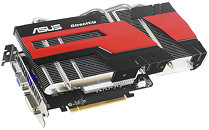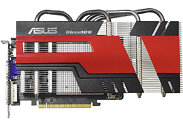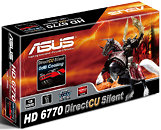Monday, August 1st 2011

ASUS Ready with HD 6770 DirectCu Silent Graphics Card
ASUS is ready with a new silent (passive-cooled) graphics card based on the AMD Radeon HD 6770 graphics processor, the ASUS HD 6770 DirectCu Silent. ASUS designed a new passive GPU cooler from ground up, which makes use of heat pipe direct-touch design, which ASUS refers to as DirectCu (direct copper). The cooler is essentially a large aluminum fin heatsink that uses four nickel-plated copper heat pipes, conveying heat to a large aluminum fin stack, that is longer than the card's PCB itself.
Based on the 40 nm "Juniper" silicon, the HD 6770 is a rebrand of the HD 5770, it packs 800 stream processors, and a 128-bit wide GDDR5 memory interface to hold 1 GB of memory. The core is clocked at 850 MHz, and memory at 1200 MHz (4.80 GHz effective). The card draws power from one 6-pin PCI-E power connector. It uses high-grade "Super Alloy" VRM components, that are efficient, and don't lose energy to high-pitched noise on load. The card's display outputs include one each of DVI, D-Sub, and HDMI 1.4a. There's no word on the pricing and availability.
Based on the 40 nm "Juniper" silicon, the HD 6770 is a rebrand of the HD 5770, it packs 800 stream processors, and a 128-bit wide GDDR5 memory interface to hold 1 GB of memory. The core is clocked at 850 MHz, and memory at 1200 MHz (4.80 GHz effective). The card draws power from one 6-pin PCI-E power connector. It uses high-grade "Super Alloy" VRM components, that are efficient, and don't lose energy to high-pitched noise on load. The card's display outputs include one each of DVI, D-Sub, and HDMI 1.4a. There's no word on the pricing and availability.



26 Comments on ASUS Ready with HD 6770 DirectCu Silent Graphics Card
8 cable-ties, along with some small nylon washers, and sticky back foam like say the thin sound insulation backing. Now I don't loop them, I thread a washer on the cable-tie; then slip that though the fin(s) in 4 places for the fan size I've chosen. Cut 4 little foam insulator pads and affix them over each screw holes on the fan to space and isolate the fan and fins. Position the fan over the 4 tie’s coming through the fins and again use the washers and ratchet block from the 4 other tie’s to tighten the fan in place. Finally trim all the ends and you have very clean, tight, mounting that doesn’t ruin the heat sink. Been doing it like that for years.
They could charge the same amount for ones without it. More profit!?
Confusing to say the least.
would have been an interesting card if it had 1 each DVI, HDMI, mDP
and the heatsink is nearly twice the length of the actual card